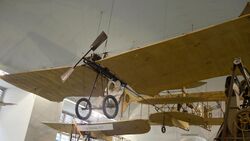Engineering:Grade monoplane
| Grade monoplane | |
|---|---|

| |
| Role | sports aircraft |
| National origin | Germany |
| Designer | Hans Grade |
| First flight | 17 August 1909 |
| Number built | ~80 |
The Grade monoplane was a single-seat aircraft constructed by Hans Grade in 1909. It was the first successful heavier-than-air aircraft produced in Germany, and around 80 were eventually built.[1]
Design and development
The aircraft was a high-wing monoplane, with the pilot sitting below the wing. A pair of inverted V struts formed the fabric-covered cabane structure which carried the upper bracing wires: the front struts were continued below the wing, with the forward struts bearing the mainwheels. An elongated cruciform tail unit was attached to the end of a single boom by a universal joint immediately behind the single tailwheel. Lateral control was effected by wing-warping.[2] It was powered by a 12 kW (18 hp) two-stroke air-cooled V-4 engine, also built by Grade,[3] which drove a two-bladed aluminium bladed propeller.[2]
Operational history
The aircraft was first flown on 17 August 1909[1] A series of longer flights were made in September, and on October 30 Grade won the Lanz prize of 40,000 marks for the first German-built aeroplane to fly in a figure 8 round two markers a kilometre apart.[2]
Grade used the money from winning the Lanz prize to establish an aircraft manufacturing business and flying school at Bork, near Magdeburg. The aircraft were sold for 12,000 marks, the price including a course of flying instruction.[3]
Grade competed with some success at the Heliopolis aviation meeting held in Egypt in January 1910, when he won one of the daily speed and distance competitions by flying 20 km (12 mi) in 22 m 57 sec.[4]
An example was bought by the Japanese army, and was the first aeroplane to be flown in Japan.[5]
Survivors
- A restored aircraft is on display at the Magdeburg Technikmuseum.[1]
- A restored aircraft is on display at the Deutsches Museum in Munich, with the original engine displayed separately.[3]
- A replica is displayed at the Kakamigahara Aerospace Science Museum [5]
Specifications
Data from Deutsches Museum, Munich[3]
General characteristics
- Crew: 1
- Wingspan: 10.2 m (33 ft 6 in)
- Wing area: 25 m2 (270 sq ft)
- Empty weight: 125 kg (276 lb)
- Gross weight: 200 kg (441 lb)
- Powerplant: 1 × Grade air-cooled V-4 two-stroke piston engine, 12 kW (16 hp)
- Propellers: 2-bladed, 1.83 m (6 ft 0 in) diameter
Performance
- Maximum speed: 60 km/h (37 mph, 32 kn)
References
- ↑ 1.0 1.1 1.2 "Hans Grade monoplane". Magdeburg Museum of technology. http://www.technikmuseum-magdeburg.de/en/ausstellung_exponat_detail.html?id=87&page=0.
- ↑ 2.0 2.1 2.2 "The Grade Monoplane". Flight: 791. 11 December 1909. http://www.flightglobal.com/pdfarchive/view/1909/1909%20-%200789.html.
- ↑ 3.0 3.1 3.2 3.3 "Grade-Monoplane, 1909". Deutsches Museum. http://www.deutsches-museum.de/en/collections/transport/aeronautics/propeller-planes/up-to-1918/grade/.
- ↑ "The Heliopolis Meeting". Flight: 111. 12 February 1910.
- ↑ 5.0 5.1 "Kakamigahara Aerospace Science Museum". Nagoya International Center. http://www.nic-nagoya.or.jp/en/e/archives/7057.
 |


